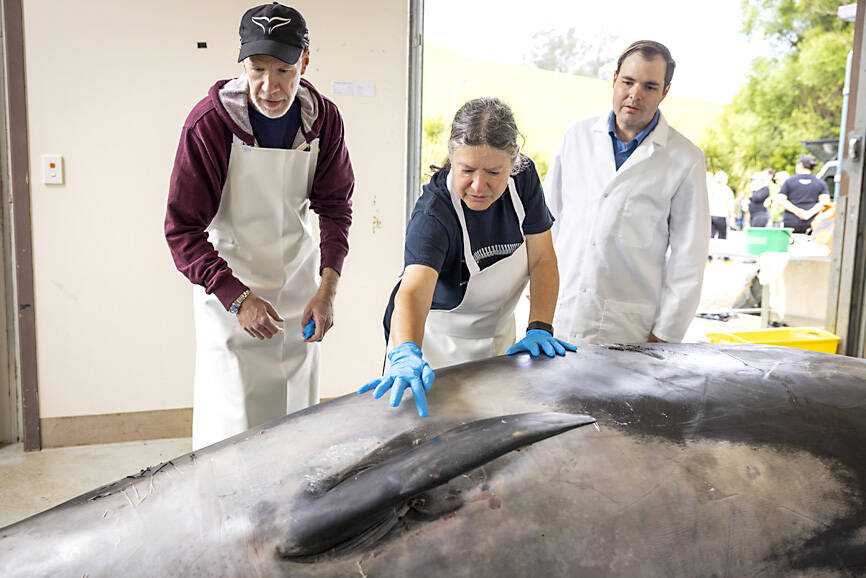It is the world’s rarest whale, with only seven of its kind ever spotted. Almost nothing is known about the enigmatic species, but on Monday a small group of scientists and cultural experts in New Zealand clustered around a near-perfectly preserved spade-toothed whale hoping to decode decades of mystery.
“I can’t tell you how extraordinary it is,” said a joyful Anton van Helden, senior marine science adviser for New Zealand’s conservation agency, who gave the spade-toothed whale its name to distinguish it from other beaked species. “For me personally, it’s unbelievable.”
Van Helden has studied beaked whales for 35 years, but Monday was the first time he has participated in a dissection of the spade-toothed variety. In fact, the careful study of the creature — which washed up dead on a New Zealand beach in July — is the first ever to take place.

Photo: AP
None has ever been seen alive at sea.
The list of what scientists do not know about spade-toothed whales is longer than what they do know. They do not know where in the ocean the whales live, why they have never been spotted in the wild, or what their brains look like. All beaked whales have different stomach systems and researchers do not know how the spade-toothed processes its food. They do not know how this one died.
Over the next week, researchers studying the 5m-long male at an agricultural research center near the city of Dunedin hope to find out.
“There may be parasites completely new to science that just live in this whale,” said Van Helden, who thrilled at the chance of learning how the species produces sound and what it eats. “Who knows what we’ll discover?”
Only six other spade-toothed whales have ever been found, but all those discovered intact were buried before DNA testing could verify their identification.
New Zealand is a whale-stranding hot spot, with more than 5,000 episodes recorded since 1840, according to the New Zealand Department of Conservation.
The first spade-toothed whale bones were found in 1872 on New Zealand’s Pitt Island. Another discovery was made at an offshore island in the 1950s, and the bones of a third were found on Chile’s Robinson Crusoe Island in 1986.
DNA sequencing in 2002 proved that all three specimens were of the same species — and that it was distinct from other beaked whales — but researchers studying the mammal could not confirm whether the species was extinct until 2010, when two whole spade-toothed whales, both dead, washed up on a New Zealand beach. However, none has been studied before.
The seventh of its kind, surrounded by white-aproned scientists who were measuring and photographing, on Monday appeared relatively unblemished, giving no clue about its death. Researchers pointed out marks from cookiecutter sharks — normal, they said, and not the cause.
The dissection would be quiet, methodical and slower than usual, because it is being undertaken in partnership with the Maori. To the Maori, whales are a taonga — a precious treasure — and the creature would be treated with the reverence afforded to an ancestor.
Members of the local iwi, or Maori people, would be present throughout the dissection and consulted at each turn, allowing them to share traditional knowledge and observe customs, such as saying a karakia (prayer) over the creature before the study begins.
“According to our beliefs and our traditions, this whale is a gift of Tangaroa, deity of the ocean,” Tumai Cassidy said. “It’s very important for us to respect that gift and to honor the whale.”
The iwi are to keep the jawbone and teeth of the whale at the end of the dissection, before its skeleton is displayed in a museum. 3D printing would be used to replicate those parts, using a CT scan taken of the whale’s head this week.
“It all builds a richer picture for that species, but also tells us how it interacts with our oceans,” Cassidy said.
It is thought that spade-toothed whales live in the vast Southern Pacific Ocean, home to some of the world’s deepest ocean trenches. Beaked whales are the ocean’s deepest divers for food, and the spade-toothed might rarely surface, adding to its mystery.
The assembled scientists on Monday included a few who had traveled from abroad to see the whale, which was put in refrigerated storage after its discovery.
“What we are interested in is not only how these animals died, but how they lived,” said Joy Reidenberg, a comparative anatomist from the Icahn School of Medicine at Mount Sinai in New York. “In discovering how they live, we are hoping to find discoveries that we can apply back to the human condition.”

A missing fingertip offers a clue to Mako Nishimura’s criminal past as one of Japan’s few female yakuza, but after clawing her way out of the underworld, she now spends her days helping other retired gangsters reintegrate into society. The multibillion-dollar yakuza organized crime network has long ruled over Japan’s drug rings, illicit gambling dens and sex trade. In the past few years, the empire has started to crumble as members have dwindled and laws targeting mafia are tightened. An intensifying police crackdown has shrunk yakuza forces nationwide, with their numbers dipping below 20,000 last year for the first time since records

CAUSE UNKNOWN: Weather and runway conditions were suitable for flight operations at the time of the accident, and no distress signal was sent, authorities said A cargo aircraft skidded off the runway into the sea at Hong Kong International Airport early yesterday, killing two ground crew in a patrol car, in one of the worst accidents in the airport’s 27-year history. The incident occurred at about 3:50am, when the plane is suspected to have lost control upon landing, veering off the runway and crashing through a fence, the Airport Authority Hong Kong said. The jet hit a security patrol car on the perimeter road outside the runway zone, which then fell into the water, it said in a statement. The four crew members on the plane, which

Japan’s ruling Liberal Democratic Party (LDP) and its junior partner yesterday signed a coalition deal, paving the way for Sanae Takaichi to become the nation’s first female prime minister. The 11th-hour agreement with the Japan Innovation Party (JIP) came just a day before the lower house was due to vote on Takaichi’s appointment as the fifth prime minister in as many years. If she wins, she will take office the same day. “I’m very much looking forward to working with you on efforts to make Japan’s economy stronger, and to reshape Japan as a country that can be responsible for future generations,”

Indonesia was to sign an agreement to repatriate two British nationals, including a grandmother languishing on death row for drug-related crimes, an Indonesian government source said yesterday. “The practical arrangement will be signed today. The transfer will be done immediately after the technical side of the transfer is agreed,” the source said, identifying Lindsay Sandiford and 35-year-old Shahab Shahabadi as the people being transferred. Sandiford, a grandmother, was sentenced to death on the island of Bali in 2013 after she was convicted of trafficking drugs. Customs officers found cocaine worth an estimated US$2.14 million hidden in a false bottom in Sandiford’s suitcase when